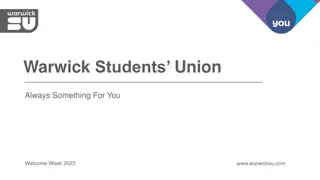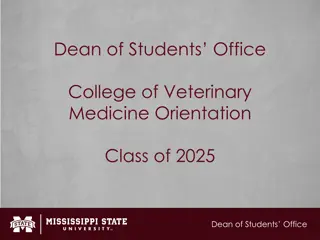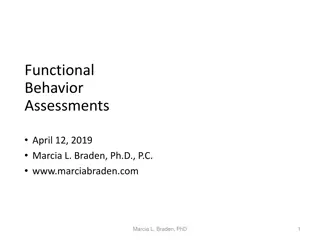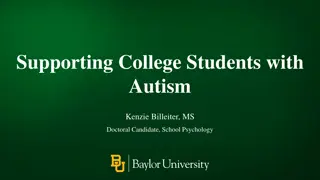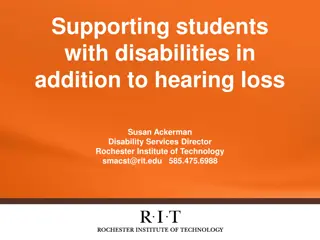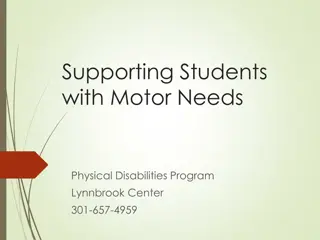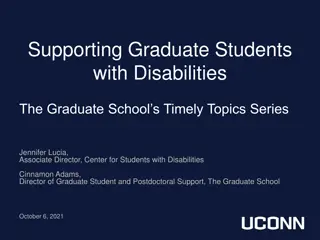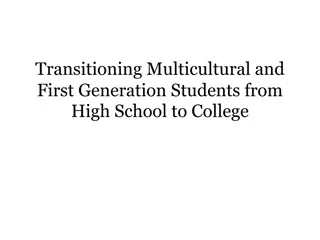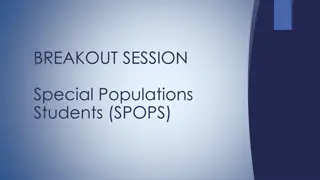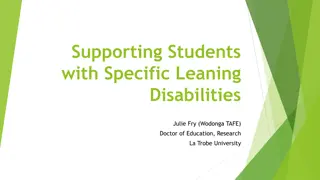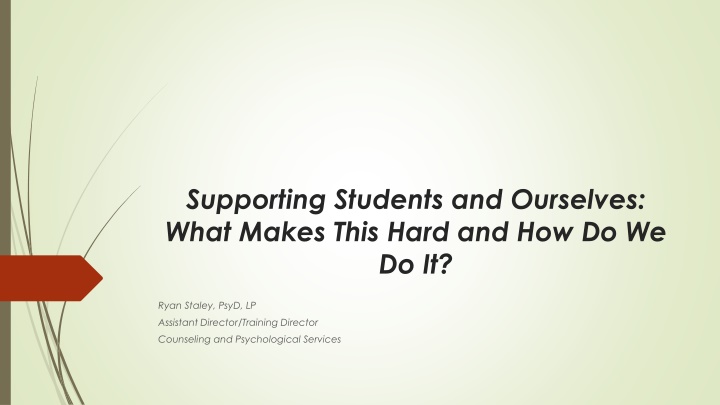
Supporting College Student Mental Health Challenges: Barriers and Solutions
Learn about the rising mental health needs among college students, common barriers to seeking mental health resources, and the crucial role of faculty in supporting student well-being. Gain insights on the impact of stigma, lack of support, and financial constraints on students' mental health, along with strategies to address these challenges effectively.
Download Presentation

Please find below an Image/Link to download the presentation.
The content on the website is provided AS IS for your information and personal use only. It may not be sold, licensed, or shared on other websites without obtaining consent from the author. If you encounter any issues during the download, it is possible that the publisher has removed the file from their server.
You are allowed to download the files provided on this website for personal or commercial use, subject to the condition that they are used lawfully. All files are the property of their respective owners.
The content on the website is provided AS IS for your information and personal use only. It may not be sold, licensed, or shared on other websites without obtaining consent from the author.
E N D
Presentation Transcript
Supporting Students and Ourselves: What Makes This Hard and How Do We Do It? Ryan Staley, PsyD, LP Assistant Director/Training Director Counseling and Psychological Services
Mental Health Needs in College Students on the Rise (Healthy Minds Study 2022-23 Data Report) Sample of 76,000 plus college students invited to complete various measures assessing various mental health issues/concerns, level of impairment, hx of mental health, lifestyle behaviors, and attitudes toward mental health. Large proportion of students responses to screeners indicated challenges with depression (41%), anxiety (36 %), Self-Injury (29 %), Suicidal Ideation (14 %), Eating Disorders (14 %) On clinically validated mental health screening instruments: 42% of student respondents reported S/I or sxs suggestive of dep., anx., ED, or NSSIBs if were seen by a clinician. Among students struggling w/ mental health problems, 45%are not receiving services/tx 77% of students reported that emotional or mental health difficulties negatively affected academic performance 1 or more days a week. Another Study showed more than 60 % of colleges students met criteria for at least 1 mental health disorder during the 2020-21 school year; 50 % increase from 2013 (Lipson, S. K., et al., Journal of Affective Disorders, Vol. 306, 2022) Studies show all races affected by mental health issues, but White students are much more likely than students of other race/ethnicities to seek services. May be related to lack of diversity among college counseling center staff; we need staff the more accurately reflect the ethnic/racial make up of student body.
Barriers to Seeking Mental Health Resources for Students: Top 3 Reasons as cited in Wiest, L. R. & Treacy, A. C. (2019). Faculty Preparation to Work with College Students with Mental Health Issues. Educational Research: Theory and Practice, 30(1), 46-50. Stigma (self and perceived stigma of others)- 41 % of respondents in Health Minds Study indicated a belief that other people would think less of them if they sought mental health services. Insufficient Mental Health Support- Increased demand for mental health services has impacted students ability to obtain timely help. Cost-Some students are without health insurance and don t make enough money to cover basic needs in addition to rising tuition costs. Other Barriers Identified by students in other studies: Preference for dealing with MH problems on own, lack of time, skeptical about effectiveness of MH tx, problems will get better on their own.
Role of Faculty in Supporting Student Mental Health According to Health Minds Network Survey: 1685 faculty members at 12 different colleges/universities across country 87% believed student mental health worsened during the pandemic, 73% would welcome additional professional development on topic of student mental health, 80% had 1 on1 conversations with students in the past 12 months. 61%believed it should be mandatory that all faculty receive basis training in how to respond to students experiencing mental or emotional distress Other considerations: Faculty in a unique position to observe students functioning (Gatekeeper) Students tend to seek support from other non-mental health professionals first, such as family, friends, clergy, professors/teachers, romantic partners
Challenges Faced by Faculty in Supporting Students and Themselves Feeling ill-equipped to help students with mental health issues Requires additional time to support student on top of an already demanding schedule Increasing expectations from University leaders and students to address mental health of students Lack of support for their own mental well being Feeling of responsibility to help students Surveys indicate a large number of Latinx/Black faculty believe their institutions are hostile or somewhat hostile toward students of color- Surveys of faculty also revealed that many believe supporting students mental health has taken a toll on their own.
So How Can Faculty Support Both Students and Themselves? What have you found works? What have your learned about what doesn t work?
Ways to Support Students Be flexible about deadlines as appropriate/needed when students communicate with you about personal challenges impacting academics Include a statement on mental health in course syllabus: helps set the expectation/normalize the need to seek help and highlights link between mental health and academic performance. Offer mental health days: Build into course requirements Provide information to students about resources on campus and in the community; consider having various student wellbeing offices present info. about services during a class. Be open about your own efforts to care for yourself/cope with challenges-students need role models to learn ways to cope/view help seeking as strength Establish class conditions and norms that are conducive to self-care and promoting help seeking- See above (due dates, MH days, flexible deadlines) Know common signs of student distress and connect help connect students to appropriate resources/services. Be willing to talk openly with students about any concerns you may have about them.
Common Indicators of Distress Student appears or often conveys they are overwhelmed Significant change in academic performance/behavior: missing classes, not completing work, declining grades Physical changes: hygiene, fatigue, dramatic weight loss/gain Behavior that is unusual or not characteristic of the student Intense emotional reactions Requesting/needing an inordinate amount of support Agitation/Anger outbursts Disjointed thoughts-Not clearly connected Rapid/Slowed speech Tearfulness Communicating threatening statement about self/others Other faculty/staff/students expressing concerns/complaints Withdrawal Dramatic Mood changes
How to Talk To Students of Concern Talk: to student in private when you both have time so not rushed. Listen: with sensitivity, validation, empathy, and in a nonthreatening way. Discuss your observations in behavioral/nonjudgmental terms. I ve noticed you ve missed class a lot lately and I am concerned. Communicate: understanding by repeating back in your own words what student has said. Include both feelings and content Give Hope: assure student that help is available. Help student ID options for action and explore possible consequences. Maintain: clear and consistent boundaries/expectations. Be direct/honest with student about your ability to help. Refer: when problem is more serious than you feel comfortable handling or other expertise/support is needed beyond what you can provide.
Referral to CAPS and What to Expect First step would be to provide student with information about CAPS, ways we can be helpful and encourage them to stop by for a walk-in consultation appointment. The student can expect to complete a few brief surveys upon arrival at CAPS. Responses to the screeners/surveys helps the front desk staff determine with whom the student will meet for an initial appointment. The initial appointment will be focused on assessing the students immediate needs/concerns and discussing a plan for care moving forward that may include CAPS, campus, and community resources/services.
A Little about KSU CAPS Located at 1105 Sunset Ave., Rm. 101, Manhattan, KS 66502-Lower level of Lafene Health Center Services provided include individual/group therapy, skills workshops, ADHD evaluation, and crisis services Services offered at CAPS, with the exception of ADHD evaluations, are covered by student fees Students are afforded 8 individual therapy sessions per semester and unlimited group therapy session Mental health support is available to students after hours and on weekends by calling 785-532-6927 Clinicians are available to faculty and staff for consultation as needed to support students of concern.
Campus Resources Student Success and Accountability Student Access Center KSU Counseling and Psychological Services Lafene Health Center Center for Advocacy Response and Education KSU Police Department KSU LGBTQ Resource Center International Student and Scholar Services Power Cat Financial Cats Cupboard Office of Institutional Equity Academic Achievement Center
What About You? What are ways you care for yourselves? What are barriers to effectively care for and meeting your personal needs? How have you tried to overcome these barriers?
Ways to Care for/Support You Sleep, eat, and move Time management: prioritized task lists, be proactive about a plan for completing tasks Build in time for restorative/enjoyable activities Address problems/challenges as they arise and seek help when needed Make time for social connection/utilize social support Use professional resources as needed: EAP (https://www.k-state.edu/hr/benefits/perks- programs/eap.html), regular medical check-ups, and use of medical services when ill Consult, seek help from, other professional/personal resources (i.e., colleagues, family/friends, supervisors, spiritual leader/clergy, medical/mental health) Engage in relaxation exercises Set boundaries clear boundaries w/ others and in various life domains to a help live a more balance life. Practice mindfulness.
References Ableson, S. (2019) 4 Ways Faculty Can Be Allies for Student Mental Health. Association for College and University Educators. https://acue.org/blog/4-ways-faculty-can-be-allies-for-college-student-mental- health Flaherty, C. (2021, April 20) Faculty: Gate Keepers of Students Mental Health. Inside Higher Education. https://www.insidehighered.com/news/2021/04/08/faculty-gatekeepers-student-mental-health Healthy Minds Network (2023). Health Minds Study among Colleges and Universities, year (2022-2023) [Data set]. Health Minds Network, University of Michigan, University of California Los Angeles, Boston University, and Wayne State Universtity. Healthy Minds Network (2021). Healthy Minds Study among Colleges and Universities, year (2013- 2021) [Data set]. Healthy Minds Network, University of Michigan, University of California Los Angeles, Boston University, and Wayne State University. https://healthymindsnetwork.org/research/data-for- researchers Vyletel, B., Voichoski, E., Lipson, S., & Heinze, J. (2023) Exploring faculty burnout through 2022-2023 HMS faculty/staff survey. American Psychological Association. https://www.apa.org/ed/precollege/psychology-teacher-network/introductory-psychology/faculty- burnout-survey Wiest, L. R. & Treacy, A. C. (2019). Faculty Preparation to Work with College Students with Mental Health Issues. Educational Research: Theory and Practice, 30(1), 46-50.


